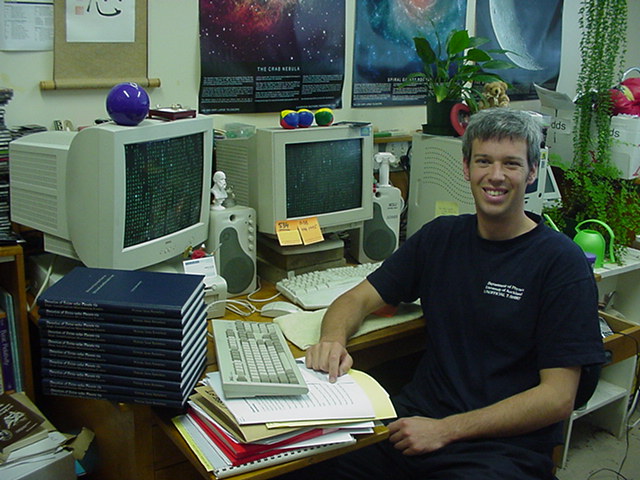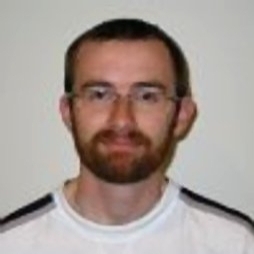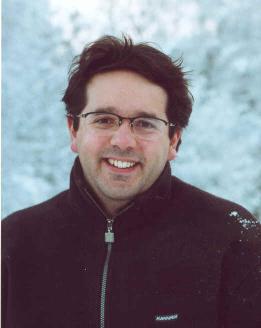|
|
 st-andrews.ac.uk
st-andrews.ac.uk

|
Prof Keith Horne RoboNet microlensing programme and automated target selection Professor of Astronomy SUPA, University of St Andrews School of Physics & Astronomy, North Haugh, St Andrews, KY16 9SS, United Kingdom Phone: +44-1334-463322, E-mail: kdh1  st-andrews.ac.uk st-andrews.ac.uk
Keith has pioneered the search for extra-solar planets exploiting the technique of gravitational microlensing using robotic telescopes, which are ideally suited for time-critical programmes due to their flexible scheduling and fast response time. He devised the first algorithm that distributes telescope time amongst observable targets in order to maximize the planet detection efficiency. As principal investigator of the RoboNet microlensing programme, he has contributed to the vast majority of the microlensing planet discoveries to date, the five Earth-mass planet OGLE-2005-BLG-390Lb being the most spectacular of these. He is also involved in the SuperWASP consortium, hunting for planets from transits in front of their host stars. Beyond the study of extra-solar planets and the implications for extra-terrestrial life, Keith is interested in a wide range of further topics, including in particular Active Galactic Nuclei, astrotomography, and alternative theories of gravity. |

|
Dr Nicholas J. Rattenbury Anomaly detection and event modelling Postdoctoral Research Associate Jodrell Bank Centre for Astrophysics Alan Turing Building, The University of Manchester, Manchester, M13 9PL, United Kingdom Phone: +44-161-275 4087, Fax: +44-161-275 4247, E-mail: nicholas.rattenbury  manchester.ac.uk manchester.ac.uk
Nicholas received his PhD from The University of Auckland, New Zealand, for his work on the detection of extra-solar planets via high-magnification microlensing events. Prior to this he spent 6 months observing at the Mount John University Observatory in the South Island of New Zealand for the Microlensing Observations in Astrophysics (MOA) collaboration. Nicholas has been a member of the MOA collaboration since 1998, and is currently a postdoctoral research associate at Jodrell Bank Centre for Astrophysics, University of Manchester, England. His research interests have extended to include the use of the OGLE microlensing suvey datasets for investigations into Galactic dynamics, structure and nearby stars. Along with Martin Dominik, Nicholas developed SIGNALMEN, a code for the automatic detection of planetary anomalies in microlensing events. Nicholas is co-creator, co-producer and interviewer for The Jodcast, a twice-monthly astronomy podcast from The University of Manchester. In his spare time (?), Nicholas can be found reaching a state of calm practicing t'ai chi. |

|
Dr Valerio Bozza Real-time modelling of binary-lens events Staff Researcher Università degli Studi di Salerno Dipartimento di Fisica "Eduardo R. Caianiello" Via Ponte Don Melillo, 84084 Fisciano (SA), Italy Phone: +39-089-969347, E-mail: valboz  sa.infn.it sa.infn.it
Valerio was born in 1976 in Salerno (Italy). He got his PhD in 2002 with a thesis on Pre-Big Bang cosmology, under the joint supervision of Gaetano Scarpetta and Gabriele Veneziano at CERN. He then got a Prestige Grant from "Centro Enrico Fermi" for staying three more years at CERN. He then moved back to Salerno to become a staff researcher in 2011. He has always cultivated multiple interests: String Cosmology, Cosmological perturbations, Maximal Acceleration, Gravitational lensing, Supermassive Black Holes, and Microlensing of course. He is now working on a completely automatic real-time modelling software, which should yield models for binary and planetary microlensing events within one hour without any human intervention. He is also active in fine modelling of specific events. He loves mountaineering and is also committed to the local section of the Italian Alpine Club. |

|
Dr Yiannis Tsapras Data analysis and event modelling Post-doctoral Research Astronomer Las Cumbres Observatory Global Telescope Network 1 Morpeh Wharf, Birkenhead, Merseyside, CH41 1NQ, United Kingdom Phone: +44-151-650 3100, Fax: +44-151-650 3113, E-mail: ytsapras  lcogt.net lcogt.net
Yiannis was born in Athens (Greece) in 1975. He received an MSc in Radioastronomy from The University of Manchester (England) in 1999 for his work in characterizing weather effects on various instruments used for studies of the Cosmic Microwave Background. With moving to the University of St Andrews (Scotland), his research interests shifted to extra-solar planets and to the optical part of the electromagnetic spectrum. In 2002, he received a PhD in Astronomy for his research work on modelling and analyzing microlensing events. Since then, Yiannis has worked at Queen Mary, University of London (England) as a member of the POINT-AGAPE team and as a term-time lecturer, and more recently, he has held a data-analysis position at the Astrophysics Research Institute (ARI) of Liverpool John Moores University (England), substantially contributing to the success of the PLANET/RoboNet microlensing campaign. Currently, Yiannis holds a research contract with Las Cumbres Observatory, and continues his work on extra-solar planets and public science outreach. When not looking for new planets, he can be most commonly found gaming on-line, or with a book in his hands, or listening to chilled-out music while drinking freshly brewed coffee. |

|
Dr Colin Snodgrass Event prioritisation ESO Post-doctoral Research Fellow European Southern Observatory (ESO) Alonso de Cordova 3107, Casilla 19001, Santiago 19, Chile Phone: +56-2-463 3069, E-mail: csnodgra  eso.org eso.org
Colin Snodgrass is a Scottish astronomer. He studied at St Andrews, graduating with a MSci in Astrophysics in 2003. He became involved in the search for extra- solar planets by microlensing at St Andrews during 2002 and 2003, working on the development of the web-PLOP observation prioritisation system and on the use of microlensing data to put constraints on the population of planets towards the the galactic bulge. Colin then moved to Queen's University, Belfast in Northern Ireland where he changed fields slightly and obtained (in 2006) his PhD based on studies of the nuclei of comets. Colin now works at the European Southern Observatory in Chile, where he is a post-doctoral research fellow. He combines functional work as a member of the La Silla Science Operations team with his research. This research covers a broad spectrum of planetary science, continuing the comets and Solar System work from his PhD and also returning to work on extra-solar planets and in particular microlensing. He is involved in updating the observing prioritisation system to maximise the chances of detecting planets with robotic telescopes, working with the RoboNet collaboration, and also observes in the old fashioned human based way for the PLANET project, who use the Danish 1.54m telescope on La Silla. When not travelling or spending time on a mountain for work, Colin likes to travel and climb mountains. |

|
Dr Rachel Street Hunting for exoplanets at Las Cumbres Observatory Astronomer Las Cumbres Observatory Global Telescope Network 6740 Cortona Dr. Suite 102, Santa Barbara, CA 93117, United States of America Phone: +1-805-880 1631, E-mail: rstreet  lcogt.net lcogt.net
Rachel graduated with a Ph.D. in Astronomy from the University of St Andrews in 2002 having specialized in searching for extra-solar planets using the method of transits to survey open clusters with the Wide Field Camera on the Isaac Newton Telescope, La Palma. While no planets were found, the work encouraged an interest in the low mass binaries which are a natural by-product of this type of survey. Rachel became involved with the WASP Consortium during this time and moved to Queen's University, Belfast to work on the SuperWASP project, contributing primarily to the development of the data reduction pipeline and to the selection and analysis of candidates. The WASP Consortium announced the discovery of two new transiting planets in 2006, and three further ones in 2007. Rachel joined Las Cumbres Observatory in February 2007 as a post-doc affiliated with the University of California, Santa Barbara (UCSB). In addition to SuperWASP, she is collaborating with the RoboNet microlensing project, using the Las Cumbres Observatory Global Telescope Network to identify planetary anomalies in ongoing galactic microlensing events. |

|
Prof Shude Mao Theory of Gravitational Microlensing Professor of Astrophysics Jodrell Bank Centre for Astrophysics , University of Manchester Alan Turing Building, Manchester, M13 9PL, United Kingdom Phone: +44-161-2754197, E-mail: shude.mao  manchester.ac.uk manchester.ac.uk
Shude Mao was born in 1966 in China, pursued his undergraduate degree at University of Science & Technology of China (1984-1988) and PhD at Princeton University and from 1988-1992. He then travelled to Harvard-Smithsonian Centre for Astrophysics (1992-1995) and Max-Planck Institute for Astrophysics (1995-1999) for two postdocs. He has been in the Department of Physics and Astronomy of University of Manchester since December 1999. He started to work on microlensing under the guidance of Prof. Bohdan Paczynski at Princeton University. He is interested in a variety of topics on microlensing, including binary & planetary microlensing, and the study of Galactic structure using microlensing data. His other interests are on galaxy formation and galactic dynamics. |

|
Dr Lukasz Wyrzykowski OGLE team member, observing and modelling of microlensing events STFC Research Associate Institute of Astronomy, University of Cambridge Madingley Road, Cambridge, CB3 0HA, United Kingdom Phone: +44-1223-337504, E-mail: wyrzykow  ast.cam.ac.uk or wyrzykow ast.cam.ac.uk or wyrzykow astrouw.edu.pl astrouw.edu.pl
Lukasz was born in 1977 in Choszczno (Poland), studied astronomy at the Physics Faculty of Warsaw University and graduated in 2001. He got involved in the Optical Gravitational Lensing Experiment (OGLE) project in 2000 and in his PhD thesis at the Warsaw University Astronomical Observatory (under supervision of Prof. Andrzej Udalski) he analysed the microlensing data of the Galactic Bulge from the OGLE. During his doctorate studies he spent the academic year 2003/2004 as a researcher in the Wise Observatory at Tel-Aviv University (Israel). In 2004/2005 he was a Marie Curie Training Site Fellow in the Jodrell Bank Observatory at Manchester University (UK) and worked with Prof. Shude Mao. He also spent a month in 2005 working with Prof. Bohdan Paczynski at Princeton University. After finishing his PhD in 2005, he started his 2.5 years postdoc, funded by the European-Union sponsored Marie Curie network ANGLES, in the Institute of Astronomy at the University of Cambridge, where in 2008, he started his work on photometry and science alerts of the GAIA satellite. He is actively involved in the OGLE project taking his observing runs in Chile and analysing the data. His main interests cover detecting microlensing events and their anomalies due to planets, binary lens or variable stars, modelling exotic events and applying the microlensing technique to studies of various stellar populations. His name is pronounced as: woo-cash vy-zy-kov-ski. |

|
Dr Eamonn Kerins PPARC/STFC Advanced Fellow and Lecturer Jodrell Bank Centre for Astrophysics , University of Manchester Alan Turing Building, Manchester, M13 9PL, United Kingdom Phone: +44-161-2754191, E-mail: Eamonn.Kerins  manchester.ac.uk manchester.ac.uk
|

|
Dr Peter Wheatley Associate Professor Department of Physics, University of Warwick Coventry, CV4 7AL, United Kingdom Phone: +44-247-657 4330, E-mail: p.j.wheatley  warwick.ac.uk warwick.ac.uk
|